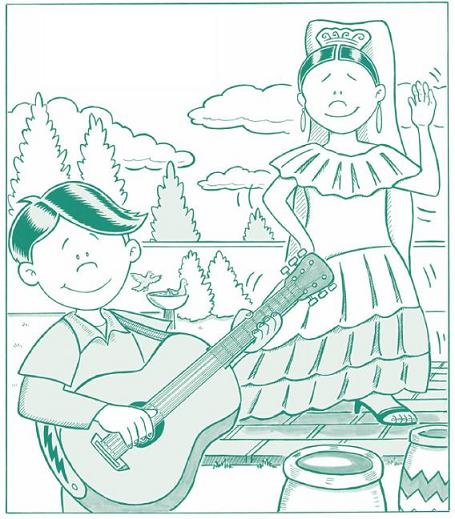
CHAPTER 7
Time and Dates
Hora y fechas

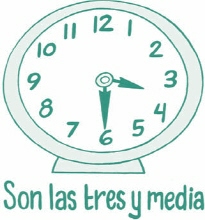
What Time Is It?—¿Qué hora es?
Telling time in Spanish is very easy, as long as you know your numbers. Good thing you’re a numbers expert since reading Chapter 1, right? If you need to refresh your memory, go back and revisit that part of the book for a few minutes.
To ask what time it is, just say ¿Qué hora es? Then to answer, you say son las and then the number. Here are some example answers:
| English | Spanish |
| It's two o'clock. | Son las dos. |
| It's three o'clock. | Son las tres. |
To say that it’s something thirty, use media (half).
| English | Spanish |
| It's 3:30. | Son las tres y media. |
| It's 4:30. | Son las cuatro y media. |
When you’re talking about time the word “quarter” means a span of fifteen minutes. To say that it’s quarter after or quarter to in Spanish, use y cuarto (quarter after) or menos cuarto (quarter to).
| English | Spanish |
| It's 5:15. | Son las cinco y cuarto. |
| It's 6:15. | Son las seis y cuarto. |
| It's 6:45. | Son las siete menos cuarto. |
| It's 7:45. | Son las ocho menos cuarto. |
For other times, like ten after and five to, you’ll use either y (if it’s time added on to the hour) or menos (if it’s time substracted from the hour), plus the the number.
| English | Spanish |
| It's 8:10. | Son las ocho y diez. |
| It's 9:20. | Son las nueve y veinte. |
| It's 10:55. | Son las once menos cinco. |
| It's 11:40. | Son las doce menos veinte. |
Talking about “A.M.” and “P.M.” is a little different in Spanish. For A.M., you can use de la mañana (in the morning): Son las seis de la mañana (It’s six A.M.) But for P.M., you have two choices: de la tarde (in the afternoon), when talking about anywhere from noon to about 6 P.M., and de la noche (in the evening or at night), for 6 P.M. to midnight. Here are some examples:
| English | Spanish |
| It's one P.M. It's one in the | Es la una de la tarde. |
| afternoon. | |
| It's seven P.M. It's seven in | Son las seis de la noche. |
| the evening. | |
| It's eleven P.M. It's eleven | Son las once de la noche. |
| at night. |
Schedules, such as for buses and trains, often talk about time using a 24-hour clock. 1 A.M. to 12 noon are easy enough, and then after that, you just continue counting up: 1 P.M. = 13, 2 P.M. = 14, etc., all the way up to midnight — 24.
Consejo
IMPORTANT TIP
¿Cómo?—
Say What?
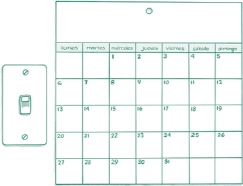
Days, months, and seasons—
Días, meses y estaciones
The Spanish days of the week are very different from the English ones:
| English | Spanish |
| Monday | lunes |
| Tuesday | martes |
| Wednesday | miércoles |
| Thursday | jueves |
| Friday | viernes |
| Saturday | sábado |
| Sunday | domingo |
Now that you know how to tell time and say the days of the week in Spanish, it’s time to practice what you’ve learned. Make a schedule of your typical day, with the times and everything you do written in Spanish. For example, you might list waking up in the morning, eating breakfast, and taking a shower before school. Revisit the section called Everyday Actions—Todos los días in Chapter 5 if you need help remembering how to say certain daily activities. Here’s a sample of what one entry in your schedule might look like:
| El día (day) | La hora (time) | La actividad (activity) |
| lunes | a las siete de la mañana | despertarse |
Here are the words for the months of the year — los meses del año:
| English | Spanish |
| January | enero |
| February | febrero |
| March | marzo |
| April | abril |
| May | mayo |
| June | junio |
| July | julio |
| August | agosto |
| September | septiembre |
| October | octubre |
| November | noviembre |
| December | diciembre |
Here are the words for the four seasons in Spanish:
| English | Spanish |
| spring | la primavera |
| summer | el verano |
| autumn | el otoño |
| winter | el invierno |
What’s your favorite season of the year? Why? A little later in this chapter, you’ll learn how to talk about weather. This will help you describe your favorite season to your friends!
¡CUIDADO!
Mistake to Avoid
Like days of the week, months are not capitalized in Spanish. Of course, if the day of the week or the month comes at the beginning of the sentence, it would be capitalized: Fui a España en mayo (I went to Spain in May). Agosto tiene treinta y un días (There are thirty-one days in August).
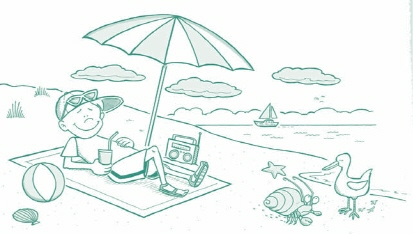
¿Cómo?—
Say What?
What’s Today’s Date?—¿Cuál es la fecha de hoy?
Talking about the date in Spanish is a little bit tricky. To ask What’s the date? say ¿Cuál es la fecha? Then you can answer with Es el (It is) plus the date.
Here are some examples:
| English | Spanish |
| It's October 2. | Es el 2 de octubre. |
| It's March 15. | Es el 15 de marzo. |
| It's December 31. | Es el 31 de diciembre. |
On the first day of the month, instead of saying uno, in Spanish you say primero, just like how in English you’d say January 1st, not January 1.
| English | Spanish |
| It's May 1st. | Es el primero de mayo. |
| It's July 1st. | Es el primero de julio. |
When you write the short form of the date in Spanish, the day still goes before the month:
| English | Spanish |
| May 30 (5/30) | mayo 30 (30/5) |
| January 20 (1/20) | enero 20 (20/1) |
Some dates can be really tricky:
| English | Spanish |
| February 3 (2/3) | febrero 3 (3/2) |
| March 2 (3/2) | marzo 2 (2/3) |
So, you really need to remember that the day goes first in Spanish, otherwise you might get the date completely wrong!
Weather—Tiempo
To talk about the weather, you need to learn a new verb: hacer. When followed by weather words related to temperature and the sky, hacer means “to be.” And the only conjugation you need is hace (it is). Here are some important sentences to know:
| English | Spanish |
| How's the weather? | ¿Qué tiempo hace? |
| It's bad weather. | Hace mal tiempo. |
| It's cold. | Hace frío |
| It's cool. | Hace fresco. |
| It's hot. | Hace calor. |
| It's nice out. | Hace buen tiempo. |
As always, there are exceptions. There are times when the verb hace doesn’t work. In those cases you need to use different verbs. Here are some examples:
| It's cloudy. | Está nublado. |
| It's sunny. | Hay sol o está soleado. |
| It's foggy. | Hay neblina. |
To talk about specific temperatures, you’ll also use hace:
| English | Spanish |
| It's 10 degrees. | Hace diez grados. |
| It's 5 degrees below zero. | Hace cinco grados bajo cero. |
For rain, snow, and hail, you need to use está (it is):
| English | Spanish |
| It's raining. | Está lloviendo. |
| It's snowing. | Está nevando. |
| It's hailing. | Está cayendo granizo. |
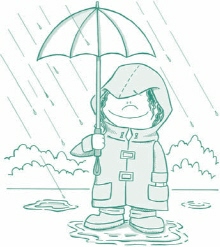
Consejo
IMPORTANT TIP
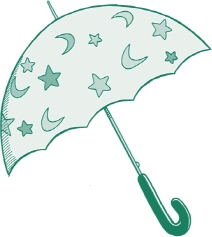
And finally, when you want to say that there is a very severe weather condition like a blizzard, you use hay (there is) plus the word:
| English | Spanish |
| blizzard | una ventisca |
| drought | una sequía |
| flood | una inundación |
| hurricane | un huracán |
| tornado | un tornado |
Holidays—Días festivos
Everybody likes to celebrate, but holidays are not the same in every country. Here are some holidays that are celebrated in the United States as well as in many Spanish-speaking countries:
| English | Spanish |
| Christmas | la Navidad |
| Christmas Eve | la Nochebuena |
| Easter | la Pascua |
| Father's Day | el Día del Padre |
| Mother's Day | el Día de la Madre |
| New Year's | el Año Nuevo |
| New Year's Eve | la Nochevieja |
| Valentine's Day | el Día de San Valentín |
Here are some dates that are special to Spanish speakers.
• January 6—Día de los Reyes Magos: The celebration of Three Kings Day, also know as Epifanía (Epiphany), is important in Catholic countries such as Spain and Latin America. This is often another day for kids to get presents, just like on Christmas.
• May 5—Cinco de Mayo: Cinco de Mayo, which of course means May 5th, is a celebration of Mexico’s defeat of the French in 1862. It is celebrated in parts of Mexico as well as cities in the United States with large Mexican populations.
• November 1—Día de los Muertos: Día de los Muertos, or Day of the Dead, is a Mexican celebration in honor of friends and loved ones who have died.
• Holy Week—Semana Santa: Semana Santa is an 8-day celebration, from Palm Sunday to Easter Monday, in many Catholic countries, including Spain, and Latin America.
Birthdays—Cumpleaños
For many people, birthdays are the most special days of all! Here are some useful phrases for talking about your own birthday, as well as those of your friends and family.
| English | Spanish |
| birthday | el cumpleaños |
| birthday cake | una torta de cumpleaños |
| birthday card | una tarjeta de cumpleaños |
| birthday party | una fiesta de cumpleaños |
| birthday present | un regalo de cumpleaños |
| Happy birthday! | ¡Feliz cumpleaños! |
In Hispanic countries, a girl’s 15th birthday—la quinceañera—is the most special. The closest equivalent in the United States is the now old-fashioned coming-out party. In Mexico and other Hispanic countries, 15 is seen as the age when a girl turns into a woman, and this is commemorated with a huge party, with many similarities to a wedding in the United States, with a church ceremony, a fancy white or light pink dress and matching bouquet, a “court” with damas (maids of honor) and chambelanes (gentlemen), party favors, and a banquet. I bet you don’t know that the party itself has a name and it is called el quinceañero. The girl turning 15 is called la quinceañera.
Consejo
IMPORTANT TIP
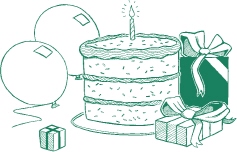
Nice Party
Find your way from el principio (the start) to el fin (the end). Circle the number of regalos de cumpleaños you travel through.
UNO
DOS
TRES
To ask how old someone is, say ¿Cuántos años tienes?
And then to answer, you need to use tengo, from the verb tener (which normally means “to have”) plus the number and then the word años (years).
| English | Spanish |
| I'm six years old. | Tengo seis años. |
| I'm ten years old. | Tengo diez años. |
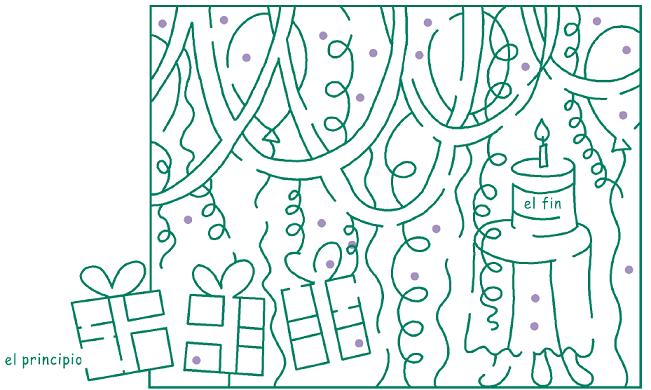
Have a short conversation with a friend about ages. Here’s a sample conversation:
ANA: Hola, Carlos.
CARLOS: Buenos días.
ANA: ¿Cuántos años tienes?
CARLOS: Tengo nueve años.
ANA: ¡Yo también!
CARLOS: ¡Qué interesante!
ANA: ¡Hasta Luego!
CARLOS: ¡Adios, Ana!
Now write your own conversation in the blank spaces provided and practice it with a friend:
| SPEAKER 1: ______________________________________________ |
| SPEAKER 2: ______________________________________________
|
| SPEAKER 1: ______________________________________________ |
| SPEAKER 2: ______________________________________________
|
| SPEAKER 1: ______________________________________________ |
| SPEAKER 2: ______________________________________________
|
| SPEAKER 1: ______________________________________________ |
| SPEAKER 2: ______________________________________________ |
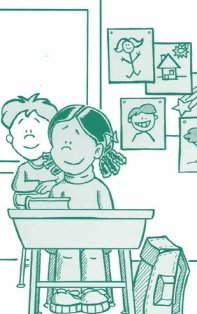
Birthdays are great! Everyone has one, and it’s a great opportunity to throw a party, eat cake, and open presents! You probably know exactly when your own birthday is, but do you know the birthdays of your friends and family members? Fill in the blanks below to help yourself remember these important days. Here’s the trick: The months are in Spanish!
| Month in Spanish | Friend or Family Member | Birth Date |
| enero | ____________________________ | |
| febrero | ____________________________ | |
| marzo | ____________________________ | |
| abril | ____________________________ | |
| mayo | ____________________________ | |
| junio | ____________________________ | |
| julio | ____________________________ | |
| agosto | ____________________________ | |
| septiembre | ____________________________ | |
| octubre | ____________________________ | |
| noviembre | ____________________________ | |
| diciembre | ____________________________ | |
For extra fun, write a short sentence about your own birthday! Find a calendar of the current year and look up what day of the week your birthday falls on. Check out the example below, and then write your own birthday sentence.
| My birthday is Tuesday, April 23. | Mi cumpleaños es el martes, el 23 de abril. |
________________________________________________________________